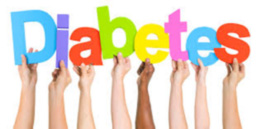
Diabetes is now one of the most common non-communicable diseases globally. According to WHO, 425 million people have diabetes. Approximately 4.0 million adults aged 20-79 years died from diabetes in 2015. It is estimated that 629 million people will have diabetes by 2045.
What is Diabetes?
Diabetes is a long term disorder characterized by a raised level of glucose (or sugar) in the blood.
Where does the glucose come from?
Glucose comes from food, particularly starchy and sugary foods (Carbohydrates)
Digestion breaks down carbohydrates into glucose which goes into your blood as energy. Some foods provide glucose very quickly e.g jams, sweets, and fruit juice while others provide glucose slowly.
The pancreas (a gland in near your stomach) makes a hormone called insulin.
Insulin is very important- It helps glucose move from the bloodstream into parts of the body which needs it for energy.
When you have diabetes your body doesn’t make enough insulin. Without insulin there will be too much sugar left in your blood (high blood glucose).
This sugar is harmful to various organs in the body such as the brain- leading to stroke, eyes- leading to impaired vision, heart attack, kidney failure etc. These lead to unnecessary and avoidable chronic conditions.
Symptoms of Diabetes include:
- Weight loss
- Dizziness
- Frequent Urination
- Excessive thirst
- Tiredness
- Blurred vision
How to Know?
Kindly visit the nearest Hospital or Laboratory for a test.
Controlled Diabetes
Fasting Blood glucose = 6.5 mmol/I/ (115 mg/dl)
2 hour post meal = 9 mmol/I/ (160 mg/dl)
Uncontrolled Diabetes
Fasting Blood glucose = 7.0 mmol/1/
2 hour post meal = 10 mmol/I/
References
Healthline.com
Communityhealth.org
